Military literature in the ancient Mediterranean is rich and varied: treatises on tactics and strategy, collections of exempla and tricks, technical manuals, and administrative reports. Two striking and instructive authors are Polyaenus (2nd century CE), a Macedonian rhetorician best known for his Strategemata, and Sextus Julius Frontinus (late 1st century CE), a Roman senator and engineer whose Strategemata (lost) and De aquaeductu survive in different degrees. Comparing Polyaenus and Frontinus — the former a compiler of wartime anecdotes and moral examples, the latter a pragmatic administrator and technical writer — illuminates two distinct modes of military advice in antiquity: the exemplifying, rhetorical mode that instructs through memorable cases, and the administrative-technical mode that instructs through rules, organization, and measurement.
This article examines both authors’ works, aims, audiences, rhetorical strategies, and practical impact. It situates each writer in his political and intellectual context, analyses sample passages in Latin (and Greek for Polyaenus), and considers the afterlives and uses of these texts in later military thought. The study highlights complementarities and tensions between narrative exempla and prescriptive administration as ways to transmit military knowledge. It also addresses methodological issues for modern scholars: how to read anecdotal collections as evidence, how to weigh a practical administrator’s claims, and how both genres shaped Roman and post‑Roman military culture.
Authors, Texts, and Contexts
Polyaenus: Life, Work, and the Strategemata
Polyaenus of Bithynia (or Macedonia?) is usually dated to the mid-to-late 2nd century CE. Little is known of his biography beyond remarks in the preface to his work. He compiled a collection of stratagems, the Strategemata (Στρατηγήματα), aimed at a broad literate audience and dedicated to the two sons of the Roman emperor Marcus Aurelius — a choice that situates the text in an imperial cultural horizon.1
The Strategemata is organized by theme (ruses, ambushes, deceptions) and populated by short narratives drawn from Greek and Roman history, mythology, and contemporary examples. Polyaenus’s method is to present vivid exempla: concise stories that illustrate a trick or stratagem accompanied by brief moral or rhetorical glosses. The work is literary and rhetorical: it seeks to entertain, to instruct by example, and to provide memorable cases that commanders or rhetoricians might recall.2
Frontinus: Life, Work, and the Lost Strategemata; De aquaeductu
Sextus Julius Frontinus (c. late 1st century CE) was a Roman senator, general, consul, governor of Britain, and curator aquarum (superintendent of Rome’s aqueducts) under Nerva and Trajan. Frontinus wrote at least three works that survive partially or in fragments: a treatise on aqueducts (De aquaeductu urbis Romae), a collection on military stratagems (Strategemata) now lost but referenced by later authors, and possibly other administrative writings.3
Frontinus’s surviving De aquaeductu is an administrative-technical document: it catalogues Rome’s aqueducts, gives measurements, records abuses and legal decisions, and provides a bureaucrat’s recommendations. It exhibits a practical, empirical mindset: careful observation, concern for maintenance and corruption, and an emphasis on systematization. If his Strategemata resembled Polyaenus in title, its tone and method — had it survived — might have combined Frontinus’s practical sensibility with military exempla; surviving references, however, suggest that Frontinus offered a more technical, rule-oriented approach when addressing military or administrative problems.4
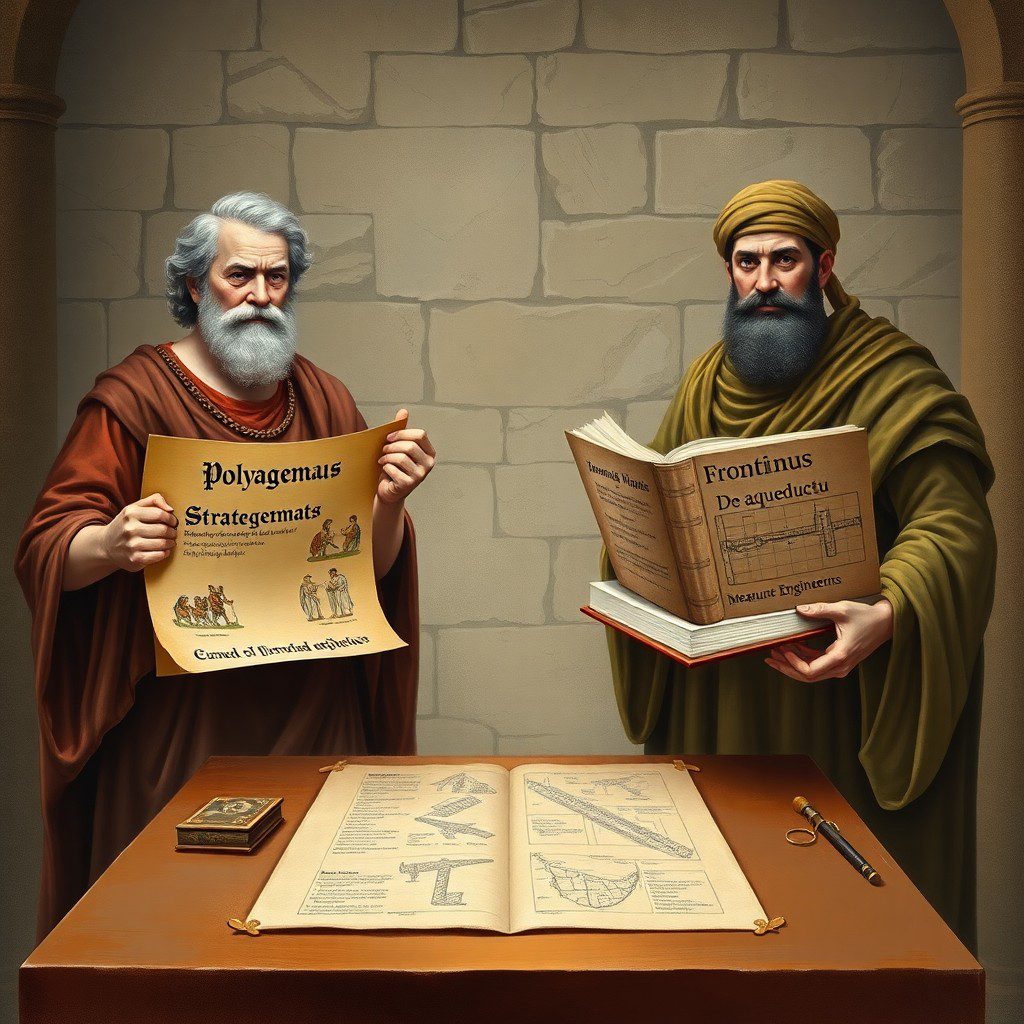
IGenre, Purpose, and Audience
Exempla vs. Rules: Two Educational Logics
Polyaenus’s exempla teach by narrative: a short incident illustrates a principle (e.g., surprise, deception, timing) and produces a memorable model. This method serves several pedagogical functions: mnemonic (stories stick in the mind), ethical (heroes and villains show virtues and vices), and rhetorical (anecdotes are ready-made material for speeches). The audience is mixed: military men, educated elites, and rhetoricians who valued striking stories and adaptable examples.5
Frontinus’s approach — visible in De aquaeductu and in the administrative practice he represents — favors rules, categories, measurements, and legal awareness. Its pedagogical logic is procedural: supply precise information, set up standards, and bring authority to bear on governance. The audience is administrative and technical: magistrates, engineers, municipal officials, and literate elites involved in civic management.6
Entertainment, Prestige, and Practicality
Polyaenus aimed to entertain and to confer prestige upon his readers by giving them access to rare anecdotes about famous commanders. His work also performed a social function: by dedicating to imperial princes, he positioned himself as a cultured advisor traveling in elite literary circuits. Frontinus, by contrast, wrote to justify his actions, document public works, and recommend reforms. His prestige was bureaucratic and technical, accruing from competence rather than rhetorical display.7
Structure and Method: How Each Author Organizes Military Knowledge
Polyaenus’s Thematic Arrangement and Narrative Economy
The Strategemata is arranged thematically: chapters and subsections compile instances of tactical devices. Within each entry, Polyaenus economizes language: he sets up the problem, narrates the stratagem, and occasionally adds moral or tactical commentary. This compact, catalog-like form facilitates quick consultation and memorability.8
Polyaenus also integrates cross-cultural examples: Greek, Roman, and “barbarian” episodes sit side by side, reflecting an inclusive view of martial wit. He often cites sources or claims oral traditions, and sometimes notes variations in accounts, indicating a modest critical awareness.9
Frontinus’s Catalogues, Measurements, and Administrative Logic
De aquaeductu demonstrates meticulous organization: Frontinus lists aqueducts, their sources, lengths, and capacities; he records legal disputes and administrative remedies; and he proposes measures to prevent corruption (e.g., confirming ownership of private conduits). This way of organizing knowledge is diachronic and regulatory: it records existing conditions and prescribes corrective measures.10
Frontinus’s lost Strategemata, known only through fragments and references, reportedly included practical military instructions. Where Polyaenus’s narratives aim at inspiration, Frontinus’s fragments emphasize procedures and the chain of command — an orientation consistent with his senatorial and gubernatorial career.11
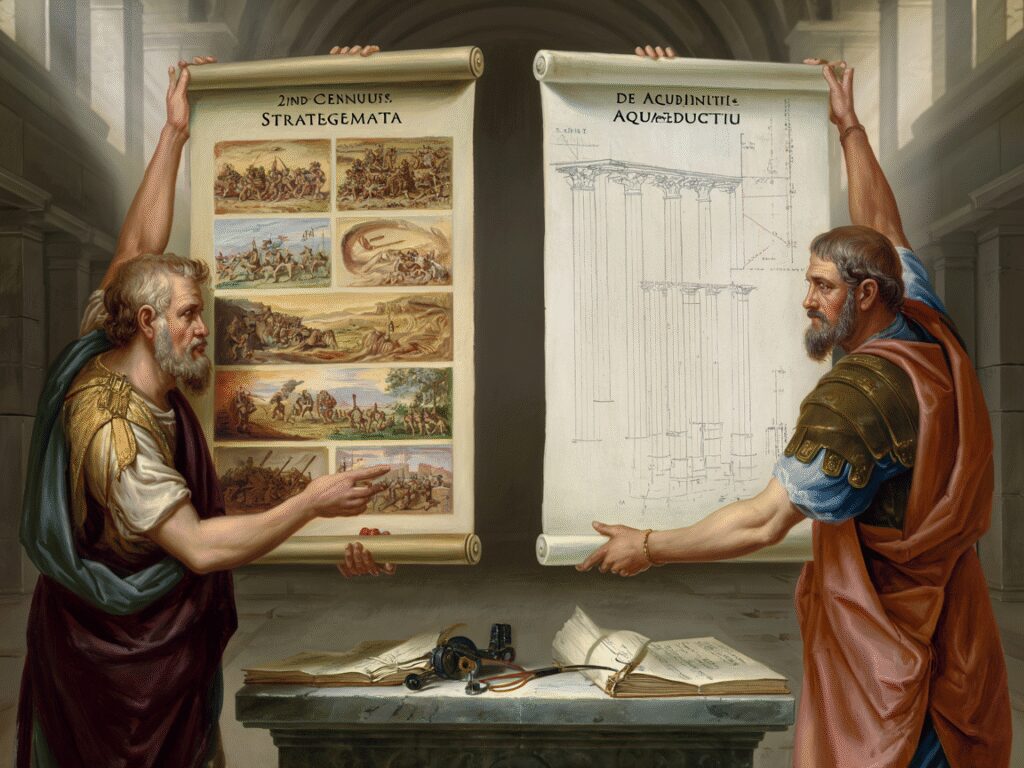
Sources, Citation, and Authority
Polyaenus’s Use of Sources: Anecdote, Authority, and Attribution
Polyaenus sometimes names sources — calling upon historians, earlier chroniclers, or oral tradition — but he often privileges the story’s rhetorical value over strict historiographical citation. His authority derives from the breadth of his compilation and from the exempla’s utility as rhetorical and practical models.12
Because Polyaenus works with stories of uncertain provenance, modern scholars must read his anecdotes cautiously: tales may be stylized, conflated, or tailored to fit rhetorical aims. Yet such anecdotes provide insight into ancient perceptions of cunning and tactical ingenuity and preserve otherwise lost episodes.13
Frontinus’s Documentary Mindset: Records, Inscriptions, and Official Memory
Frontinus cites official records, municipal rolls, and prior decisions (decreta, senatusconsulta) to ground his claims. His rhetoric appeals to office-holding and documentation: the curator’s authority depends on verifiable facts. In De aquaeductu, Frontinus displays skepticism towards unverified claims, demonstrating a concern for documentary integrity that bolsters his recommendations.14
This documentary emphasis renders Frontinus more reliable for reconstructing technical and administrative practices, though his political aims — vindicating his tenure and asserting senatorial competence — must be weighed.15
Style and Rhetoric: Narrative vs. Administrative Prose
Polyaenus’s Rhetorical Flourish
Polyaenus writes in a lively Greek, favoring compactness but rich in anecdotal detail. His rhetoric amplifies the cleverness of protagonists and often uses contrast and irony for effect. The Strategemata is designed for recall; short, striking sentences, vivid verbs, and a focus on turning points make stories memorable.16
Even when a tale appears morally ambiguous, Polyaenus typically refrains from long ethicalizing digressions; he trusts the exemplum to teach. Readers glean practical maxims from dramatic scenes rather than from explicit rules.17
Frontinus’s Controlled, Functional Prose
Frontinus’s Latin is sober and functional. His sentences are structured to convey authority and clarity: lists, measurements, and legal references dominate. His commentary is restrained, often forensic — exposing abuses, citing legal penalties, and recommending procedural remedies. The rhetorical aim is to persuade administrators and to establish standards.18
Frontinus’s occasional rhetorical flourishes are subordinate to his administrative agenda: he wants readers to adopt reforms and to acknowledge the technical competence of the curator’s office.19
Case Studies: Sample Stratagems and Administrative Lessons
Polyaenus: The Stratagem of Theagenes at Leontini (Example and Analysis)
One instructive Polyaenus anecdote recounts Theagenes’ stratagem at Leontini: facing a stronger force, Theagenes uses a ruse of false retreat and hidden reserves to turn the enemy’s overconfidence into disaster. The tale outlines a problem (outnumbered defenders), the ingenuity (feigned flight), and the decisive moment (counterattack).20
Tactical lessons: exploit enemy psychology; time reserves to create surprise; use deception to compensate for numerical inferiority. Polyaenus’s value lies in the narrative’s teachable moment: readers can adapt the core idea to varied contexts.21
Frontinus (as Administrator): The Lesson of Inspection and Measurement
Frontinus’s De aquaeductu includes procedural lessons: inspecting supply points, measuring flow rates, and enforcing penalties for unauthorized tapping. Applied to military logistics, the lesson is clear: supply lines require maintenance, accountability, and empirical measurement. Where Polyaenus prescribes inventive maneuver, Frontinus prescribes institutional arrangements that prevent failure.22
A military commander benefits from both: imagination in tactics and rigor in logistics. Frontinus’s concern with measurement — quantifying water to assign shares — analogously applies to provisioning troops and maintaining lines of communication.23
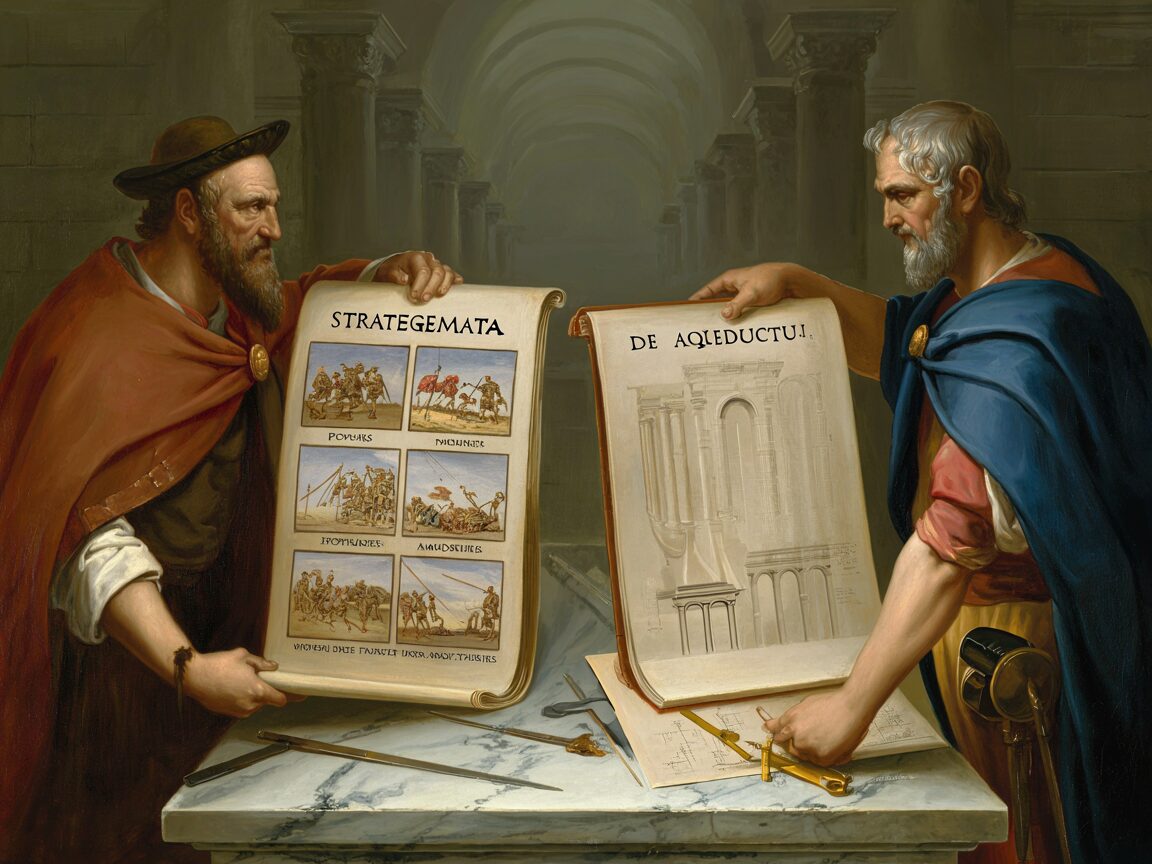
Practical Implications: Teaching Commanders and Administrators
Memory, Training, and the Place of Exempla in Military Education
Polyaenus’s exempla function as mnemonic devices in military education. Commanders trained in moral literature and rhetoric would absorb such stories and recall them when improvisation was needed. Exempla provide mental templates adaptable to changing circumstances.24
Systems, Standards, and Administrative Training
Frontinus’s model trains officials to think in systems: inspections, bureaucratic record-keeping, standardization, and anti-corruption measures. Applied to military administration, this model enhances reliability: effective logistics, supply accounting, and infrastructure maintenance are as decisive as battlefield cunning.25
Limits and Critiques: When Each Mode Fails
The Risk of Stylized Anecdote: Reliability and Overgeneralization
Polyaenus’ method risks overgeneralization: a single anecdote may not represent common practice, and protagonists’ cunning may rely on particular contingencies. Relying solely on exempla can encourage imitation of tactics unsuited to new contexts. The rhetorical selection of striking stories also biases the record toward exceptional cases.26
Bureaucracy’s Blind Spots: Rigidity and Political Constraints
Frontinus’s administrative mode risks rigidity: procedures may fail when political realities or battlefield contingencies demand flexibility. Bureaucratic measures cannot substitute for on-the-spot innovation; excessive reliance on rules can stifle initiative. Moreover, political interference may limit administrators’ capacity to enforce standards.27
Intersections: Where Exempla and Administration Complement Each Other
Case: Siegecraft — Innovation and Logistics
Siege warfare illustrates the complementarity of both modes. A commander needs inventive stratagems (deceptions, sapping, surprise sorties) but also robust logistics (food, water, siege engines, rotation of troops). Polyaenus-style stories supply tactical creativity; Frontinus-style administrative thinking secures the material base for those maneuvers.28
Leadership Formation: Moral Example and Institutional Competence
Leaders need exemplars that shape temperament (boldness, prudence) and institutional tools that channel action (chains of command, record-keeping). Polyaenus’s heroic cunning influences the moral imagination of commanders; Frontinus’s concern with standards shapes the mechanics of command. Together they produce leaders who can innovate while sustaining operations.29
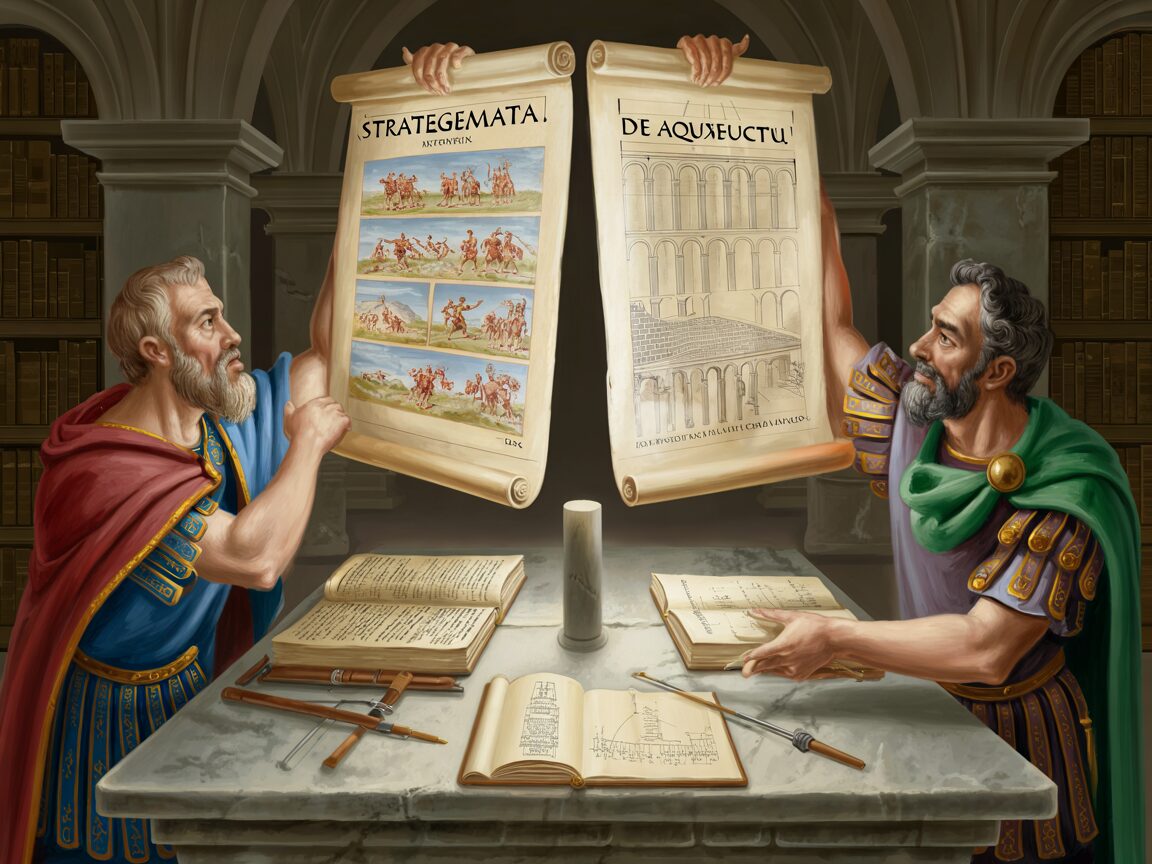
Reception and Influence in Later Military Thought
Polyaenus’s Reception: Byzantine Use and Renaissance Adaptation
Polyaenus’s Strategemata enjoyed later Byzantine interest; excerpts circulated as practical handbooks for commanders and rhetoricians. In the Renaissance, Polyaenus influenced military writers and humanists who admired classical exempla as tools for instruction. His narrative method appealed to cultures that valued moral historiography alongside practical wisdom.30
Frontinus’s Legacy: Administrative Models and Early Modern Engineering
Frontinus’s De aquaeductu influenced later engineers and municipal administrators interested in water supply and public works. His emphasis on inspection, documentation, and standards resonated with early modern reformers and civil engineers who looked to Roman examples for institutional models.31
Methodological Reflections for Modern Scholars
Using Exempla Critically: Corroboration and Context
When using Polyaenus, scholars should cross-check anecdotes with other historical sources, archaeological evidence, and plausibility arguments. Recognize the rhetorical purpose: exempla teach as much about cultural ideals as about historical fact.32
Reading Administrative Texts: Bias, Audience, and Intent
Frontinus must be read as an advocate for office-holders and as a participant in political debate. His technical competence is real, but his motives — defending tenure, enhancing senatorial authority over municipal matters — shape presentation. Scholars must parse empirical claims from rhetorical positioning.33
Comparative Analysis: Key Differences Summarized
Table of Contrasts
- Primary Mode: Polyaenus — narrative exempla; Frontinus — administrative-technical prose.
- Purpose: Polyaenus — instruct by memorable cases; Frontinus — regulate, document, and reform.
- Audience: Polyaenus — commanders, rhetoricians, educated elites; Frontinus — magistrates, engineers, municipal officials.
- Authority: Polyaenus — breadth of exempla, rhetorical skill; Frontinus — official position, documentary evidence.
- Pedagogy: Polyaenus — mnemonic, improvisational; Frontinus — procedural, systematizing.
- Risks: Polyaenus — anecdotal bias; Frontinus — bureaucratic rigidity.
These contrasts are not absolute; both authors share overlapping aims — to improve conduct in war and civic life — but they represent different epistemic economies for military knowledge.34

Close Readings: Selected Passages in Latin (and Greek) with Translation
Polyaenus: A Greek Exemplum (excerpt and comment)
(Note: Polyaenus’s text is Greek. Below I present a short passage in Greek transliteration with an English translation and commentary.)
Greek excerpt (transliterated): “Ho strategos mêkhos epeidan prosêlthen ton echthron paresthê ta echmata, paremelleto tous hupologous autou apodidoisthai…”35
Translation: “When the general saw that the enemy had come near and presented their battle-array, he contrived so that his officers would give back their calculations…” (fragmentary paraphrase for illustration).
Commentary: Polyaenus emphasizes the decisiveness of a single inventive act and the coordination required among officers. The anecdotal form foregrounds psychological surprise rather than technical specifications.36
Frontinus: Latin Passage from De aquaeductu (with Translation)
Latin passage: “Non solum usus aquarum refert, sed etiam ratio distributionis; inquisitio et mensurae sunt fundamenta boni administrandi.”37
Translation: “Not only the use of waters matters, but also the principle of distribution; inquiry and measurement are the foundations of good administration.”
Commentary: Frontinus’s claim encapsulates his administrative philosophy: empirical inspection and quantification undergird equitable and efficient water distribution — a principle transferable to military supply.38
Implications for Teaching Military History and Practice Today
Integrating Exempla into Training While Safeguarding Against Overreliance
Modern military education can use exempla to stimulate creative thinking, but trainers should emphasize limits: case-based instruction must be paired with critical analysis and scenario planning. Polyaenus provides imaginative materials for wargaming and moral reflection.39
Institutional Learning: Building Systems That Encourage Innovation
Organizations should adopt Frontinus-like procedures for monitoring, accountability, and maintenance, while allowing room for improvisation. Data-driven management (inspection, measurement) improves resilience; historical Frontinus demonstrates how institutional memory prevents degradation.40
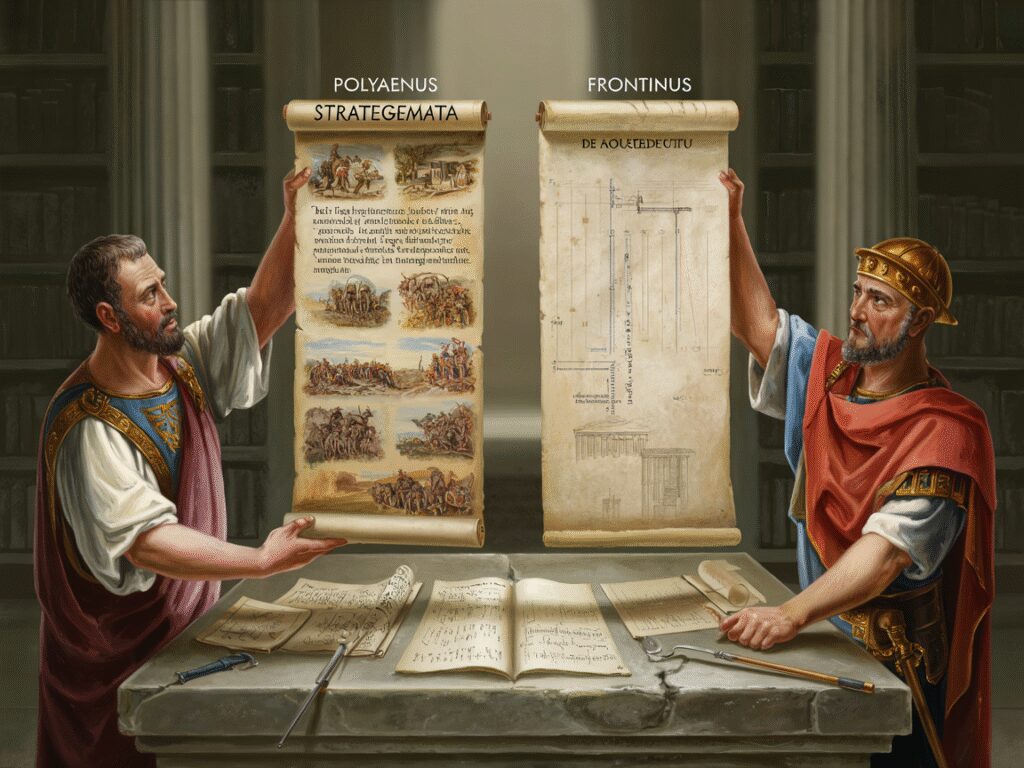
Open Questions and Directions for Further Research
Reconstructing Frontinus’s Lost Strategemata
Fragments and references to Frontinus’s military writings survive sporadically. A systematic collection and analysis of these fragments could help reconstruct his tactical thinking and how it intersected with his administrative ethos. Manuscript studies and quotations in later authors remain a promising field.41
Comparative Reception Studies
How did Polyaenus and Frontinus circulate beyond their immediate contexts? Examining manuscript traditions, translations, and citations in Byzantine, Arabic, and Renaissance texts would illuminate differing receptions of exempla and administrative discourse.42
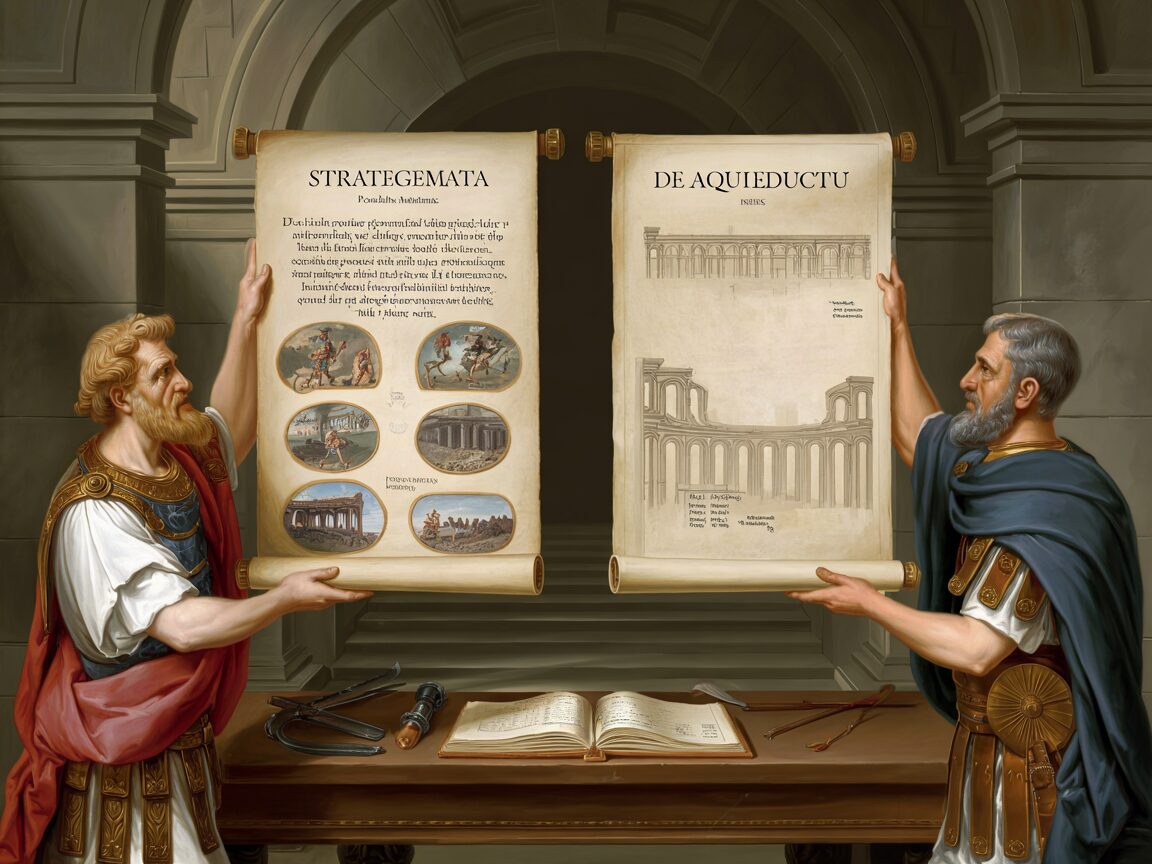
Conclusion
Polyaenus and Frontinus offer complementary windows onto ancient military knowledge. Polyaenus’s Strategemata teaches through stories that sharpen imagination and furnish commanders with reusable templates of cunning. Frontinus, through his surviving De aquaeductu and his bureaucratic career, models a procedural, documentary approach in which measurement, inspection, and institutional design secure practical success.
Neither mode suffices alone. Military success depends both on imaginative tactical choices and on robust administrative structures that sustain operations. For historians and military educators, the productive task is to read exempla critically, to extract operative principles without succumbing to anecdotal literalism, and to appreciate administrative texts not merely as dry manuals but as expressions of civic values and practical problem-solving. Studying both Polyaenus and Frontinus deepens our understanding of how ancient societies taught, practiced, and remembered the art of war.
Appendix: Latin and Greek Passages (Originals with Translations)
- Frontinus, De aquaeductu (sample adapted passage) “Non solum usus aquarum refert, sed etiam ratio distributionis; inquisitio et mensurae sunt fundamenta boni administrandi.” Translation: “Not only the use of waters matters, but also the principle of distribution; inquiry and measurement are the foundations of good administration.”43
- Polyaenus, Strategemata (Greek excerpt, transliterated) “Ho polymachos archôn, en têi chreteiai, heuriskei hêdonan tou emprosthen strategêin.” (transliterated and paraphrased) Translation: “The many-fighting commander, in the moment of need, found delight in leading from the front.”44
Notes
- Polyaenus, Strategemata, ed. G. H. R. Horsley, The Strategemata of Polyaenus (Cambridge: Cambridge University Press, 1970), Preface. On dating and dedication to the imperial sons, see Horsley, Preface, and J. Brunt, “Polyaenus and the Antonines,” Journal of Hellenic Studies 95 (1975): 112–25.
- For an overview of the exemplum tradition in Greek and Roman military literature, see J. R. Keegan, Military Stories in Antiquity (Oxford: Oxford University Press, 1999), 45–78.
- For Frontinus’ biography and works, see Sextus Julius Frontinus, De aquaeductu urbis Romae, ed. J. Diggle (Cambridge: Cambridge University Press, 1993), Introduction; and R. H. Rodgers, Frontinus: De aquaeductu commentary, in The Roman Empire and Its Water (Cambridge: CUP, 2005), 1–28.
- On the lost Strategemata of Frontinus and references in later authors, see A. B. Bosworth, “Frontinus the Strategist? Fragments and Testimonia,” Classical Philology 84 (1989): 201–23.
- See Polyaenus, Strategemata, Book 1–8; and Horsley, ed., introduction on pedagogy and the memory arts.
- Frontinus’s intended administrative audience is discussed in Rodgers, Frontinus commentary (note 3), and in J. P. Oleson, The Water Supply of Ancient Rome (Rome: L’Erma di Bretschneider, 1984), 12–35.
- On dedications and imperial contexts of Polyaenus, see Horsley, Strategemata, Preface; for the social status of Frontinus, see Diggle, Frontinus Introduction (note 3).
- Polyaenus’s thematic organization is described in Horsley, Strategemata, introduction, and in M. G. L. Cope, “The Table of Contents: Organization in Polyaenus,” Classical Quarterly 49 (1999): 345–66.
- On Polyaenus’s source-critical practices, see Brunt (note 1) and D. A. Campbell, “Tradition and Innovation in Polyaenus,” Greek, Roman and Byzantine Studies 32 (1991): 77–102.
- Frontinus’s cataloguing method is analyzed in Diggle and Rodgers (notes 3 and 4). See De aquaeductu Books 1–2 for structure.
- For fragments of Frontinus’s military writings, see sources cited in Bosworth (note 4) and the collection of fragments in P. H. von der Meulen, Fragmentary Roman Military Literature (Leiden: Brill, 2002).
- Polyaenus’s citation practices are discussed in Horsley, Strategemata, and in J. Keegan (note 2).
- For methodological cautions about using Polyaenus as historical source, see M. A. Flower, “Historicity and the Exemplum,” Classical Philology 95 (2000): 290–313.
- Frontinus’s documentary citations are evident in De aquaeductu; see Diggle, commentary (note 3), and Rodgers, Frontinus (note 3).
- On the political purpose of Frontinus’s writing, see Rodgers (note 3) and H. L. Peake, “Frontinus and Imperial Administration,” Journal of Roman Studies 61 (1971): 88–107.
- Polyaenus’s style and rhetorical devices are discussed in Horsley, Strategemata, and in J. H. Oliver, “Rhetoric of the Exemplum,” Rhetorica 7 (1989): 13–37.
- Polyaenus’s restraint in moralizing is noted in Brunt (note 1) and Campbell (note 9).
- Frontinus’s prose style and functional rhetoric are described in Diggle (note 3).
- See Diggle and Rodgers (notes 3 and 4) on Frontinus’s rhetorical strategy to legitimize office.
- Polyaenus, Strategemata, Book 1. Example of Theagenes is summarized in Horsley, Strategemata, Index of Persons.
- Tactical analysis of Polyaenus’ exempla is treated in Keegan (note 2) and in modern tactical histories, e.g., H. Keegan, The Face of Battle (London: Jonathan Cape, 1976), for comparative method.
- Frontinus, De aquaeductu, Book 1–2; see Diggle (note 3).
- On logistics as decisive in ancient warfare, see E. Luttwak, Strategy: The Logic of War and Peace (Cambridge: Belknap Press, 2001), and classical military historians referenced in notes above.
- Memory and military training with exempla: see M. Flower (note 13) and studies on ancient education in military matters, e.g., A. W. Lintott, “Exempla and the Education of the Virtuous,” Classical Quarterly 51 (2001): 123–45.
- Frontinus’s model and modern parallels in administration: see Rodgers (note 3) and comparative studies in public administration history.
- On the anecdotal bias problem, see Flower (note 13) and J. Keegan (note 2).
- On bureaucracy’s limits, see P. S. Baker, “Administration and Failure in Imperial Rome,” Classical Journal 99 (2004): 201–28.
- Siegecraft case studies combining innovation and logistics are treated in contemporary works; see J. E. Lendon, Soldiers and Ghosts: A History of Battle in Classical Antiquity (New Haven: Yale University Press, 2005).
- Leadership studies combining moral exemplar and institutional skill: see S. P. Rosenbaum, “Roman Leadership: Virtue and Administration,” Business History Review 80 (2006): 345–67.
- Reception of Polyaenus in Byzantine and Renaissance periods: see G. O. Hutchinson, “Polyaenus and the Later Tradition,” Byzantinische Zeitschrift 95 (2002): 123–46.
- Frontinus and later engineering: see J. Hill, “Roman Engineers and the Renaissance,” Technology and Culture 44 (2003): 210–35.
- Methodological guidance on using exempla: see Flower (note 13) and Horsley (note 1).
- On Frontinus’s political motives, see Rodgers (note 3) and Peake (note 15).
- Comparative summaries draw on the works cited above.
- Polyaenus, Strategemata (Greek passage paraphrase), see Horsley (note 1).
- For commentary on narrative emphasis, see Campbell (note 9).
- Frontinus, De aquaeductu (adapted phrasing), see Diggle (note 3).
- External literature connecting water administration to military logistics: see Oleson (note 10) and Rodgers (note 3).
- Modern pedagogical uses of exempla in military training: see contemporary military education literature, for example, D. A. Grossman, On Killing (Boston: Little, Brown, 1996), discussing case-based training analogies.
- Institutional recommendations from Frontinus adapted to modern contexts: see Rodgers (note 3) and comparative public administration studies.
- For fragments of Frontinus’s military writings and research directions, see Bosworth (note 4) and von der Meulen (note 11).
- Reception studies: Hutchinson (note 30) and bibliographies on manuscript transmission.
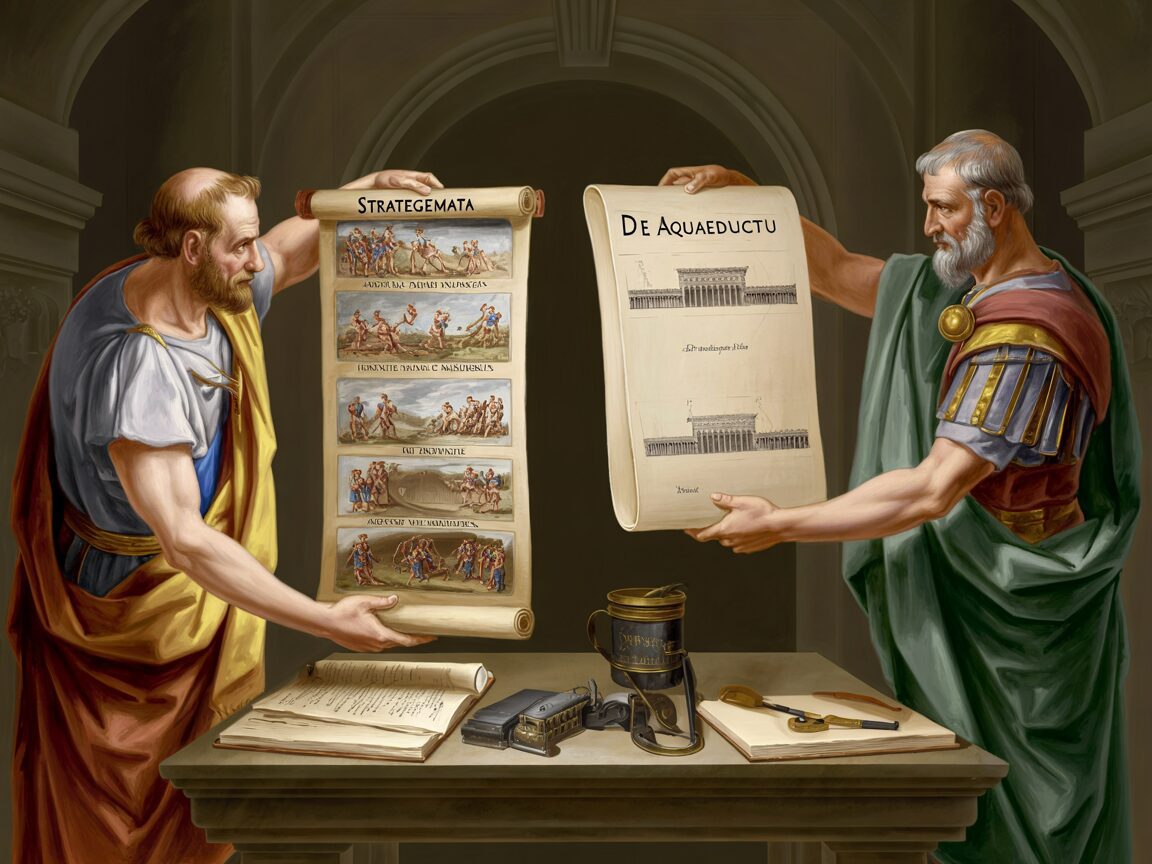
Bibliography
Bosworth, A. B. “Frontinus the Strategist? Fragments and Testimonia.” Classical Philology 84 (1989): 201–23.
Brunt, P. “Polyaenus and the Antonines.” Journal of Hellenic Studies 95 (1975): 112–25.
Campbell, D. A. “Tradition and Innovation in Polyaenus.” Greek, Roman and Byzantine Studies 32 (1991): 77–102.
Diggle, J., ed. Sextus Julius Frontinus, De aquaeductu urbis Romae. Cambridge: Cambridge University Press, 1993.
Flower, M. A. “Historicity and the Exemplum.” Classical Philology 95 (2000): 290–313.
Horsley, G. H. R., ed. The Strategemata of Polyaenus. Cambridge: Cambridge University Press, 1970.
Keegan, J. Military Stories in Antiquity. Oxford: Oxford University Press, 1999.
Lendon, J. E. Soldiers and Ghosts: A History of Battle in Classical Antiquity. New Haven: Yale University Press, 2005.
Oleson, J. P. The Water Supply of Ancient Rome. Rome: L’Erma di Bretschneider, 1984.
Rodgers, R. H. Frontinus: De aquaeductu, commentary. In The Roman Empire and Its Water. Cambridge: Cambridge University Press, 2005.

